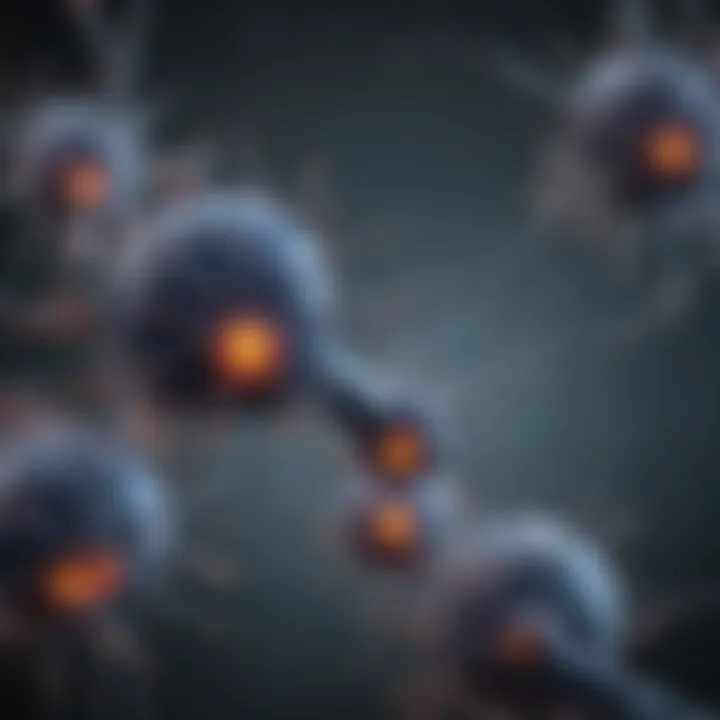Understanding Brain Neurotransmitters and Their Impact


Intro
Neurotransmitters are critical to how our nervous system operates. These chemical messengers facilitate communication between neurons, influencing various processes such as mood, cognition, and behaviors. Understanding these substances not only aids scientific inquiry but also serves practical implications in mental health treatment and neurological disorders. This investigation sheds light on the multitude of neurotransmitters, their workings, and the potential consequences of their imbalances on human health.
Research Overview
Summary of Key Findings
The examination of neurotransmitters reveals that each type plays a distinct role in neural communication. For instance, serotonin is known for its impact on mood regulation, whereas dopamine is closely linked to reward and pleasure pathways. Other neurotransmitters, like GABA and glutamate, serve essential functions in synaptic transmission and excitability. Notably, the synergistic actions of these neurotransmitters can determine the overall state of mental well-being.
Importance of the Research in Its Respective Field
This research is crucial in understanding not only the fundamental processes in the brain but also the potential ramifications of neurotransmitter imbalances. Conditions such as depression, anxiety, and schizophrenia demonstrate the outcomes of such imbalances. A thorough understanding of these chemical messengers is vital for developing effective treatments, paving the way for innovations in therapeutic approaches.
Neurotransmitter Types and Functions
Although many neurotransmitters exist, several stand out due to their significant roles:
- Serotonin: Influences mood, appetite, and sleep.
- Dopamine: Affects motivation, reward, and pleasure.
- GABA: Serves as the main inhibitory neurotransmitter, reducing neuronal excitability.
- Glutamate: The primary excitatory neurotransmitter, critical for synaptic plasticity and memory formation.
- Norepinephrine: Involved in arousal, alertness, and the body's stress response.
"Understanding these neurotransmitters can give insight not only into mental health but also into the complexities of human behavior."
Neurotransmitter Imbalances
An imbalance in neurotransmitter levels can lead to various mental health disorders. For example, low serotonin levels are commonly associated with depression. Similarly, excessive dopamine activity may contribute to psychotic symptoms found in schizophrenia. Identifying these imbalances is crucial in formulating treatment plans that may include medication, therapy, or lifestyle changes to restore equilibrium.
The End
In summary, neurotransmitters are vital components of the nervous system. They influence a wide range of functions from mood to cognitive abilities. Understanding their complexities and interactions is essential, particularly in the context of mental health. This exploration presents a foundation for future investigations into not just the biological basis of behavior but also the directions for therapeutic interventions.
Prologue to Neurotransmitters
Understanding neurotransmitters is essential in the study of the nervous system. These chemical messengers play a crucial role in facilitating communication between neurons, which influences behavior, mood, and cognitive function. The exploration of neurotransmitters introduces key concepts vital for students, researchers, educators, and professionals alike. An in-depth grasp of these chemicals allows us to appreciate their impact on mental health, which is increasingly relevant in today's society.
Researchers have identified multiple neurotransmitters, each fulfilling specific roles within the brain. By comprehensively examining their functions and interactions, we can better understand various neurological disorders, the effects of imbalances, and potential therapeutic approaches.
This section sets the stage for an elaborate discussion on neurotransmitters, making it a cornerstone for the entire article.
Definition and Overview
Neurotransmitters are endogenous chemicals that transmit signals across synapses from one neuron to another. They bind to receptors on the post-synaptic neuron, inducing a response that can be excitatory or inhibitory. This dynamic process is fundamental for various physiological functions.
We categorize neurotransmitters based on their chemical structure and function. Common types include amino acids, peptides, and monoamines. Each category has distinct characteristics that influence its role and effectiveness in neural communication. Understanding these distinctions is vital for anyone studying brain function and pathology.
Historical Context
The history of neurotransmitter research dates back to the early 20th century. In 1921, Otto Loewi conducted his famous frog heart experiment, demonstrating that nerves release chemicals to affect heart rate. This pivotal discovery laid the groundwork for modern neuropharmacology. Over the decades, advancements in biochemistry and molecular biology have identified numerous neurotransmitters, enhancing our understanding of complex neural networks.
As the field evolved, researchers began connecting neurotransmitter function to behavior and mental health. Recent studies emphasize the importance of these chemicals in the pathophysiology of various neuropsychiatric disorders. The ongoing exploration continues to shed light on their multifaceted roles in the brain, revealing significance beyond mere signaling.
Types of Neurotransmitters
Understanding the various types of neurotransmitters is essential for grasping their diverse roles in the nervous system. Each type of neurotransmitter serves unique functions, influencing everything from mood to motor function. Knowledge of these categories is crucial for researchers and healthcare practitioners since it informs therapeutic approaches and helps in diagnosing neurological disorders. This section dives into four primary categories of neurotransmitters: amino acid neurotransmitters, peptide neurotransmitters, monoamine neurotransmitters, and gas neurotransmitters.
Amino Acid Neurotransmitters
Amino acid neurotransmitters are perhaps the most abundant type found in the human brain. They serve as the building blocks for proteins and play crucial roles in neural communication. Two primary classes exist within this grouping: excitatory and inhibitory neurotransmitters.
- Excitatory Amino Acids: Glutamate is the most noteworthy among them. It enhances the firing rate of neurons, facilitating rapid communication within the brain. This neurotransmitter is vital for cognitive functions such as learning and memory.
- Inhibitory Amino Acids: Gamma-aminobutyric acid (GABA) is the main inhibitory neurotransmitter. It functions to dampen neural activity, providing balance to the brain’s excitatory responses. Disruptions in the function of these amino acids can lead to various neurological disorders and mental health issues.


Peptide Neurotransmitters
Peptide neurotransmitters consist of short chains of amino acids and are known for their roles in more complex signaling. They can be involved in modulating emotional responses, pain perception, and other autonomic functions. Examples include substance P, which is associated with pain transmission, and endorphins, which contribute to feelings of pleasure and pain relief.
Their action is often slower than amino acids, providing longer-lasting effects. Peptides also have a modulatory impact, influencing how other neurotransmitters are received or processed. This makes them crucial in understanding the complexity of conditions such as depression and anxiety.
Monoamine Neurotransmitters
Monoamine neurotransmitters are derived from single amino acids and have considerable influence on mood and emotions. This category includes serotonin, dopamine, norepinephrine, and epinephrine.
- Serotonin is known for its role in mood stabilization, appetite control, and sleep regulation. Low serotonin levels are often linked to depression.
- Dopamine is fundamental in reward processing and motivation. It regulates the brain's pleasure centers, impacting addiction and mood disorders.
- Norepinephrine plays a role in the body's response to stress and arousal, influencing attention and responding to challenges.
Overall, these neurotransmitters are integral to understanding various psychological and physiological states, particularly related to mental health.
Gas Neurotransmitters
Gas neurotransmitters such as nitric oxide (NO) represent a unique subgroup that plays a critical role in signaling. They differ from traditional neurotransmitters because they are not stored in vesicles and diffuse across membranes to exert their effects.
Nitric oxide has roles in vasodilation and neurotransmission, impacting various systems in the body. Its short-lived nature complicates its regulation but highlights the importance of transient signaling in neuronal communication. This unique aspect makes it a fascinating area of ongoing research, especially regarding its implications in neurodegenerative conditions.
Neurotransmitter Synthesis and Release
Neurotransmitter synthesis and release are fundamental processes in the functioning of the nervous system. These mechanisms ensure the availability and proper functioning of neurotransmitters, which are essential for communication between neurons. Understanding how these processes work can provide insights into various neural functions, including mood regulation, cognitive abilities, and response to environmental stimuli.
Biosynthesis Pathways
The biosynthesis of neurotransmitters is a multi-step process that begins with precursor molecules. Different neurotransmitters have distinct biosynthesis pathways. For example, dopamine is derived from the amino acid tyrosine, while serotonin originates from tryptophan. This synthesis often involves enzyme-catalyzed reactions and can occur in various locations within neurons. The efficiency of these pathways can affect neurotransmitter levels significantly.
Common neurotransmitter biosynthesis pathways include:
- Amino Acid Neurotransmitters: Glutamate is synthesized from alpha-ketoglutarate, while GABA is made from glutamate.
- Monoamines: Dopamine is formed through a series of enzymatic steps involving tyrosine. Serotonin synthesis requires multiple reactions starting from tryptophan.
- Peptides: Neuropeptides are synthesized in the cell body and transported to the nerve terminals. This process can be more complex compared to amino acids and monoamines.
By understanding these biosynthetic pathways, researchers can gain insights into how various conditions, such as nutritional deficiencies or genetic mutations, may impact neurotransmitter levels.
Storage and Release Mechanisms
Once synthesized, neurotransmitters must be stored and released appropriately to exert their effects effectively. Neurotransmitters are typically stored in specialized vesicles within the neurons. These vesicles protect neurotransmitters from degradation and ensure that they can be released promptly into the synaptic cleft when needed.
The release of neurotransmitters occurs in response to an action potential. When a neuron becomes depolarized, calcium ions enter the cell, triggering the vesicles to fuse with the presynaptic membrane. The neurotransmitters are then released into the synaptic cleft through exocytosis. This process is highly regulated and can be influenced by various factors, such as neuronal activity and external stimuli.
In summary, the synthesis and release of neurotransmitters are critical for maintaining proper neural communication. By understanding these processes better, we can appreciate their roles in health and disease.
"The delicate balance in neurotransmitter synthesis and release is crucial for overall brain health."
This intricate choreography not only sustains everyday functions but also highlights potential areas for therapeutic interventions.
Neurotransmitter Receptors
Neurotransmitter receptors are vital components of the nervous system, playing an essential role in translating chemical signals into physiological responses. These receptors are typically located on the postsynaptic membrane of neurons, where they receive neurotransmitters released from presynaptic neurons. The interaction between neurotransmitters and receptors initiates a cascade of cellular events that ultimately influences various functions such as mood, cognition, and motor control. Understanding these receptors is crucial for comprehending how neurotransmitters affect brain function and behavior.
There are two primary classes of receptors: ionotropic receptors and metabotropic receptors. Ionotropic receptors are ligand-gated ion channels that, upon binding with a neurotransmitter, open to allow ions to flow across the membrane. This can lead to rapid changes in the electrical properties of the neuron. On the other hand, metabotropic receptors are linked to intracellular signaling pathways and do not form an ion channel. Instead, they rely on G-proteins, which initiate longer-lasting effects within the cell, affecting various signaling pathways.
Types of Receptors
The diversity in receptor types is fundamental for the specificity and complexity of neurotransmission. Key types of receptors include:
- Glutamate receptors: They are responsible for excitatory neurotransmission and are crucial for synaptic plasticity, memory, and learning.
- GABA receptors: These receptors mediate inhibitory neurotransmission and play a significant role in reducing neuronal excitability and maintaining balance in the brain.
- Dopamine receptors: With several subtypes, dopamine receptors are implicated in reward processing, motivation, and regulation of mood.
- Serotonin receptors: They are involved in mood regulation, cognition, and perception. Variants of these receptors are targets for many antidepressants.
- Acetylcholine receptors: These receptors play important roles in muscle activation and cognitive functions in both the central and peripheral nervous systems.
Receptor Activation and Signaling Pathways


Receptor activation is a finely tuned process. When a neurotransmitter binds to its receptor, it causes a conformational change in the receptor protein. This change activates intracellular signaling cascades. For example, in the case of metabotropic receptors, the binding of a neurotransmitter activates G-proteins that can either open ion channels or trigger secondary messengers such as cyclic AMP or phosphoinositides. These secondary messengers can then influence cellular functions like gene expression, enzyme activity, and cellular metabolism.
"The specificity of neurotransmitter-receptor interactions is a cornerstone of how signals are relayed and processed in the central nervous system."
Functional Roles of Neurotransmitters
Neurotransmitters are far more than simple chemical messengers; they are integral to how the brain functions and influences behavior. Their roles are diverse and critical across various aspects of daily life. Understanding these functionalities elucidates the complexity of emotional and physical responses in humans.
Role in Mood Regulation
Neurotransmitters significantly impact mood and emotional states. Chemical substances such as serotonin, dopamine, and norepinephrine are directly involved in regulating feelings of happiness and sadness.
- Serotonin is often termed the "feel-good" neurotransmitter. It contributes to feelings of well-being and happiness. Imbalances in serotonin levels can lead to mood disorders such as depression and anxiety.
- Dopamine plays a role in pleasure and reward mechanisms. It is vital in regulating emotional responses and is linked to sensations of happiness and motivation. Low levels can contribute to issues like Parkinson's disease and addiction.
- Norepinephrine affects alertness and arousal, serving as a key player in the body's stress response. Its effects on mood stabilization are particularly clear in conditions such as bipolar disorder.
The balance of these neurotransmitters is crucial. When they become imbalanced, it can lead to serious mood disorders, hence why understanding their roles provides insight into mental health.
Influence on Cognition
Cognitive functions such as learning, memory, and attention are deeply tied to various neurotransmitters. Each neurotransmitter’s function is tailored to specific cognitive tasks and processes.
- Acetylcholine plays a vital role in learning and memory. Its release is critical when forming new memories and executing complex tasks. Deficits in acetylcholine are associated with Alzheimer’s disease, impacting memory severely.
- Glutamate, the primary excitatory neurotransmitter, is essential for synaptic plasticity, a mechanism that underpins memory function and learning processes.
"Understanding these neurotransmitter interactions gives vital insights into cognitive function and possible cognitive decline."
The coordination and communication between these neurotransmitters underscore their influence on cognitive clarity and problem-solving capabilities. Research continues to evolve concerning how altering neurotransmitter levels can enhance cognitive function.
Impact on Motor Function
Motor control is another critical area where neurotransmitters exert influence. Coordination and movement are dependent on a delicate balance of several neurotransmitters, particularly dopamine and acetylcholine.
- Dopamine is crucial in controlling movement and coordination. Its depletion is a hallmark of Parkinson’s disease, leading to motor symptoms such as tremors and rigidity.
- Acetylcholine is essential for muscle activation. It transmits signals from nerve cells to muscles, facilitating movement. An imbalance can disrupt communication, resulting in conditions such as myasthenia gravis.
Additionally, gamma-aminobutyric acid (GABA) serves an inhibitory role. It helps to modulate motor output, ensuring that movements are smooth and well-coordinated. The interplay of excitatory and inhibitory neurotransmitters governs the precision of motor actions. A thorough understanding of these functions contributes to developing effective interventions for motor disorders.
Neurotransmitter Imbalances
Neurotransmitter imbalances are significant as they can profoundly affect an individual's mental and physical health. These imbalances refer to conditions where there is either an excess or a deficiency of certain neurotransmitters in the brain. Since neurotransmitters govern a variety of bodily functions and mental processes, understanding their imbalances is essential for comprehending how they influence overall well-being.
Many factors can lead to imbalances, including genetic predispositions, environmental stressors, and lifestyle choices. For instance, high levels of stress may decrease serotonin levels, leading to mood disturbances. Additionally, dietary deficiencies can impact neurotransmitter production.
The ramifications of these imbalances are extensive, affecting mood, cognition, and behavior. By recognizing the implications of neurotransmitter fluctuations, we can better address mental health issues and devise effective treatment plans.
Even slight changes in neurotransmitter levels can lead to notable shifts in emotional and cognitive states.
Consequences of Imbalances
The consequences of neurotransmitter imbalances can manifest in various ways. Some common effects include:
- Mood Disorders: An excess of dopamine or a deficit in serotonin can contribute to conditions such as depression and anxiety.
- Cognitive Impairments: Imbalances may affect memory and learning, linked strongly to neurotransmitters like acetylcholine and glutamate.
- Physical Symptoms: Changes in neurotransmitter levels can result in fatigue, sleep disturbances, and alterations in appetite.
Additionally, the consequences are not localized only to mental health. For example, imbalances of norepinephrine can impact alertness and energy levels, while GABA deficiencies may lead to increased anxiety and tension. Understanding these consequences is crucial for clinicians and researchers.
Association with Mental Disorders
Neurotransmitter imbalances are closely associated with several mental disorders, emphasizing the need for deeper research in this area. Common disorders linked to these imbalances include:
- Depression: Often associated with low levels of serotonin and norepinephrine.
- Bipolar Disorder: Characterized by fluctuations in dopamine and serotonin levels, impacting mood stability.
- Schizophrenia: Abnormal dopamine levels have been observed in many patients.
- Anxiety Disorders: Typically linked to low GABA levels and excessive glutamate activity.
Understanding the association between neurotransmitter imbalances and mental disorders can guide diagnostic and therapeutic approaches. Treatments might involve pharmacological methods to restore balance through medications that adjust neurotransmitter levels. Understanding these connections provides a basis for holistic approaches that consider both psychological and biological factors.


Therapeutic Approaches
The exploration of therapeutic approaches to neurotransmitter imbalances is vital in understanding how they influence mental health. Neurotransmitters play an essential role in governing various neural functions, emotions, and behaviors. When these chemical messengers deviate from their optimal levels, it can lead to numerous psychological and neurological disorders. Therefore, effective therapeutic methods not only aim to restore balance but also enhance the overall quality of life for individuals affected by these disturbances. This section will focus on two primary therapeutic strategies: pharmacological interventions and non-pharmacological therapies.
Pharmacological Interventions
Pharmacological interventions primarily involve the use of medications to rectify neurotransmitter imbalances. These prescriptions are tailored to either increase or decrease the levels of specific neurotransmitters in the brain, which is crucial in treating mental health conditions. Some common types of medications include:
- Antidepressants: Agents like selective serotonin reuptake inhibitors (SSRIs) target serotonin levels to alleviate symptoms of depression and anxiety.
- Mood Stabilizers: Medications such as lithium help balance neurotransmitters in patients with bipolar disorder, promoting stable moods.
- Antipsychotics: These drugs can adjust dopamine levels, thus addressing psychotic symptoms rooted in disorders such as schizophrenia.
- Stimulants: They often increase dopamine and norepinephrine activity, commonly used in the treatment of ADHD.
While these interventions have shown positive results in many cases, they also come with potential side effects. Consideration of individual patient needs and responses is necessary for effective treatment. Moreover, some patients experience adverse effects that can complicate their treatment journeys.
Non-Pharmacological Therapies
In addition to medications, non-pharmacological therapies offer alternative or complementary options for addressing neurotransmitter imbalances. These approaches emphasize holistic health and focus on lifestyle changes and mental health support. Some notable therapies include:
- Cognitive Behavioral Therapy (CBT): This therapeutic model aids individuals in recognizing and restructuring negative thought patterns, positively influencing neurotransmitter activity.
- Exercise: Regular physical activity is known to boost levels of several neurotransmitters, including serotonin and endorphins, which can enhance mood and cognitive function.
- Mindfulness and Meditation: Practices that reduce stress can lead to favorable changes in the brain's chemical environment, potentially balancing neurotransmitter levels.
- Nutritional Interventions: Diet has a profound impact on neurotransmitter synthesis. A balanced diet rich in omega-3 fatty acids, antioxidants, vitamins, and minerals supports optimal neurotransmitter function.
Non-pharmacological strategies can be particularly beneficial for those seeking to avoid medication or wanting to enhance their treatment outcomes. While their effectiveness can vary from person to person, evidence supports their role in managing various mental health issues.
Recent Advances in Neurotransmitter Research
Research in neurotransmitters has undergone significant changes over the past few years. The findings in this field are crucial as they provide insights not only into the basic functions of these chemical messengers but also into various clinical applications. This section focuses on recent developments that enhance our understanding of how neurotransmitters affect behavior, health, and neurological conditions.
Current Trends in Research
In the current landscape, numerous studies are exploring the diverse roles neurotransmitters play beyond traditional views. For instance, researchers are delving into how neurotransmitter signaling is linked to the immune system. It has been found that neurotransmitters like serotonin and dopamine have roles in regulating immune response. This finding highlights the intricate relationship between mental and physical health.
Another trend involves advanced imaging techniques, like functional MRI and PET scans, which enable scientists to visualize neurotransmitter activities in real time. These technologies allow for better understanding of conditions such as depression and schizophrenia. By observing how neurotransmitters operate within the living brain, researchers can identify specific areas affected by various mental illnesses, leading to tailored therapeutic approaches.
Moreover, studies are increasingly addressing the role of the gut-brain axis, which emphasizes the connection between digestive health and neurotransmitter function. Gut microbiota communicates with the brain through neurotransmitter modulation, suggesting new pathways for treating mood disorders through dietary and probiotic interventions.
"Understanding the roles of neurotransmitters in different contexts can shape future therapeutic strategies."
Future Directions in Neurotransmitter Studies
As we look ahead, future research is likely to focus on several promising directions. Understanding how genetics influences neurotransmitter function is one avenue. Genetic variations can affect neurotransmitter metabolism, which may provide insight into individual predisposition to certain mental health conditions.
Another critical direction is the development of novel therapeutic agents targeting specific neurotransmitter systems. Current medications often work broadly, but new compounds may selectively enhance or inhibit certain neurotransmission pathways, potentially leading to more effective treatments with fewer side effects.
Furthermore, there is a growing interest in the role of neurotransmitters in neuroplasticity. This aspect is essential for understanding learning and memory processes. Clarifying how neurotransmitter involvement can facilitate or hinder neuroplastic changes can inform rehabilitation approaches for traumatic brain injuries or strokes.
Ending
The conclusion serves as a critical element of this article, synthesizing the profound insights gained from understanding brain neurotransmitters, the chemical messengers essential for neural communication. By drawing together the various components discussed, the conclusion emphasizes how neurotransmitters influence multiple aspects of behavior, cognition, and emotional well-being.
Summary of Key Points
Within the discussion on neurotransmitters, several key points emerge:
- Diversity of Neurotransmitters: Neurotransmitters can be classified into different types such as amino acids, peptides, monoamines, and gases, each having unique roles in the nervous system.
- Mechanisms of Action: The synthesis, release, and receptor interaction of neurotransmitters describe a complex yet organized process essential for effective signaling.
- Functional Roles: Neurotransmitters regulate mood, cognition, and motor functions, indicating their integral role in maintaining mental health.
- Imbalances and Disorders: Understanding neurotransmitter imbalances highlights the connections to various mental health disorders and the importance of precise regulation.
- Therapeutic Interventions: Both pharmacological and non-pharmacological therapies emerge as critical solutions to address neurotransmitter imbalances and associated symptoms.
In summary, recognizing the diverse roles and mechanisms of neurotransmitters can lead to a deeper comprehension of their impact on human behavior and society.
Importance of Continued Research
Continued research in the field of neurotransmitter studies is essential for several reasons. First, as our understanding of the human brain grows, identifying the nuances of neurotransmitter function can lead to more effective treatments for mental health disorders. For instance, breakthroughs in targeted pharmacotherapy may offer new hope for conditions previously considered difficult to treat.
Second, advancements in technology enable researchers to explore neurotransmitter dynamics at unprecedented levels of detail. This includes imaging techniques and molecular biology approaches that reveal how neurotransmitter interactions influence wider neural networks.
It is also imperative to note that the bi-directional relationship between neurotransmitters and mental health can evolve over time. As new discoveries emerge, they challenge old paradigms and open pathways for innovative therapeutic strategies.
"The future of mental health treatment lies in a deeper understanding of the brain's chemical communications."
This underscores the need for an ongoing commitment to exploring the complexities of neurotransmitter interactions. Investing resources and focus into this area will undoubtedly enrich both scientific knowledge and clinical practices.







